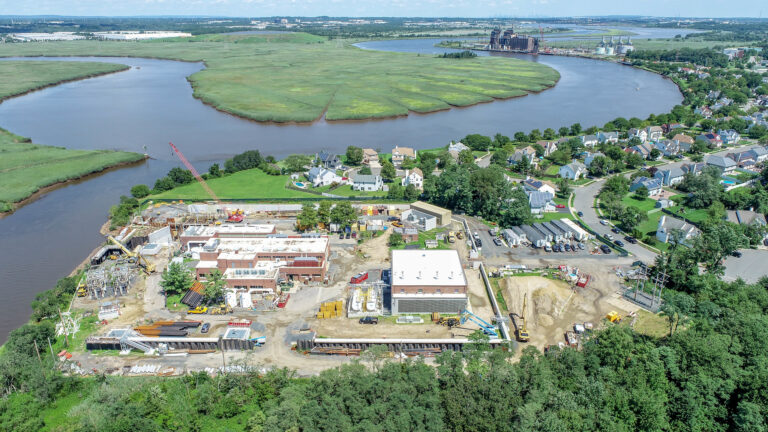
Building Resilient Water Infrastructure
Climate Change Resilience Guidance for New Jersey’s Clean Water and Drinking Water State Revolving Funds
The Resilience Guidance serves as a crucial component of the State Revolving Fund (SRF) program, with the aim of integrating climate change considerations into the Water Bank program. This guidance was developed in response to Executive Order 14008, which focuses on promoting climate resilience and reducing greenhouse gas emissions, as well as DEP Administrative Order No. 2020-01, which mandates the incorporation of climate change considerations in the Department’s programs and materials.
To assist applicants, the Resilience Guidance provides procedures for evaluating project alternatives and demonstrating the resilience of selected project alternatives concerning climate change impacts. Drawing upon the best available and most geographically relevant climate information, projections, and standards, the guidance incorporates resources such as the 2020 New Jersey Scientific Report on Climate Change, Sea-Level Rise Guidance for New Jersey, New Jersey Climate Change Resilience Strategy, and studies on extreme precipitation events.
By strategically aligning the Water Bank program with these resources, the Resilience Guidance ensures that funded projects comply with state and federal climate resilience policies. Consequently, this approach contributes to the overall goal of mitigating the impacts of climate change, enhancing the resilience of water infrastructure, and promoting sustainable development in New Jersey.
Prior to preliminary engineering work, applicants should consult with the program during their pre-planning meeting to determine specific resilience requirements relevant to their project.
Building Resilient Water Infrastructure: Climate Change Resilience Guidance
Is Your Project Exposed to Any of These Climate Impacts?
Flooding
If your project is exposed to FEMA 500 +1 foot safety factor flood elevation or the regulatory flood elevation indicated in the FHACA Rules , it is vulnerable to flooding. Some areas may need to calculate their own flood areas if FEMA maps or other resources are unavailable.
SLOSH Cat 1. Hurricane
The National Storm Surge Hazard Maps use the SLOSH (Sea, Lake, and Overland Surges from Hurricanes) model to compute storm surges. This data may not include local features such as construction walls, levees, berms, pumping systems, or other mitigation systems. Use these maps and local data to determine whether your project is vulnerable to category 1 storm surge.
Sea Level Rise
If your project is exposed to FEMA 500 + sea level rise flood elevation or the regulatory flood elevation indicated in the FHACA Rules , it is vulnerable to flooding. Use the Resilience Guidance to determine which projected year to use for sea level rise.
Extreme Precipitation
Applicants are required to use the most up to date extreme precipitation projections in their alternatives analysis to justify resilience of their project. This should include an analysis of the impact of precipitation on the project and, given its use and life cycle, the appropriate precipitation projections to be utilized. Use the New Jersey Extreme Precipitation Projection Tool to examine mid-century or end-of-century estimates.
What is the Resilience Assessment?
Resilience Assessment
The Resilience Assessment ensures that applicants seeking public funding assistance incorporate climate resilience when developing and justifying the selection of the most economical, effective, and practical project alternatives. “Climate resilience” refers to the ability of social and ecological systems to absorb and adapt to shocks and stresses resulting from a changing climate, while becoming better positioned to respond in the future.
Begin by creating project alternatives that are not only economical, practical, and effective, but also contribute to community resilience. Projects must be permittable for all current and future regulations, and project sponsors should familiarize themselves with municipal finance regulations (N.J.A.C. 7:22). To assist with planning and design for repair, rehabilitation, or construction of proposed projects, consider using resources such as the EPA Flood Resilience: A Basic Guide for Water and Wastewater Utilities , EPA’s Community-Based Water Resilience Guide, and other guides outlining adaptation measures for climate change impacts.

Asset Vulnerability
Measure the vulnerability of assets by determining their exposure, sensitivity, and adaptive capacity for each climate change impact the project is vulnerable to.
- What are the assets involved in the project and how are they exposed to climate change impacts?
- How sensitive are these assets to direct and indirect disruptions caused by climate change impacts?
- How would you rank the sensitivity of each asset based on its exposure and criticality to the level of service?
- What is the adaptive capacity of each asset, considering existing and proposed adaptation measures?
- How vulnerable is each asset, using sensitivity and adaptive capacity?

Risk Tolerance
How tolerable is the financial, environmental, and public & safety risk to the community served as a result of disruption in level of service caused by each climate impact?
- What is the level of service for the infrastructure?
- What are the consequences of a disruption in level of service economically, environmentally, and concerning public health and safety?
- How tolerable is the financial risk to the community resulting from disruptions in the level of service caused by climate change impacts?
- How tolerable is the risk to public health and safety in the event of a disaster?
- How tolerable is the risk to the environment in the event of a disaster?

Assessment and Justification of Selected Alternative
Assess community vulnerability to climate change impacts and weigh the project’s contribution to resilience by analyzing direct impacts (vulnerability and risk tolerance) and indirect impacts unrelated to level of service (LOS). Use this to justify the selected alternative.
- What is the overall vulnerability of the community to climate change impacts?
- How do the project’s direct effects on resilience compare to the community’s risk tolerance for climate change impacts?
- What indirect effects does the project have on community resilience?
- How do the direct and indirect effects of the project contribute to the overall resilience of the community?
- How does the selected alternative reduce social and ecological vulnerability and contribute to community resilience?

Questions, Comments?
Contact us.
